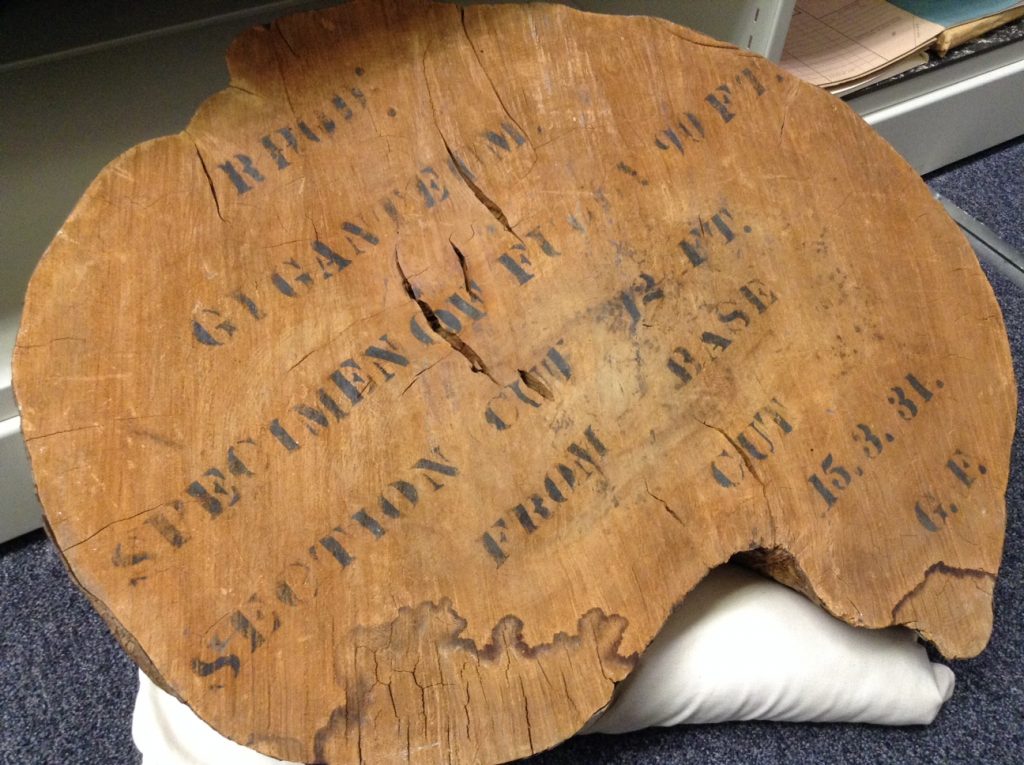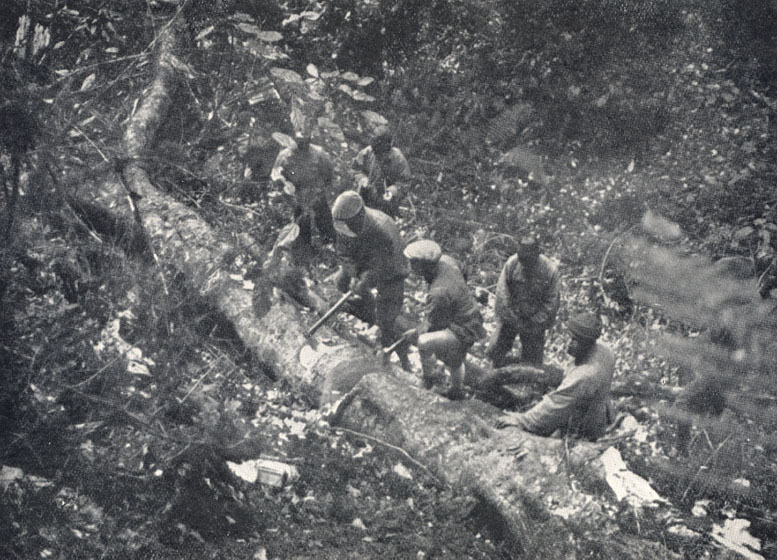Plant Collector George Forrest (1873-1932) introduced over 300 new rhododendron species to Britain but one in particular dwarfed all of these, Rhododendron protistum, which is represented in our collection by a large slice of tree trunk, felled by Forrest and his collectors in 1931 – it may even be our largest herbarium specimen?
Forrest referred to his find as Rhododendron giganteum – an appropriate name! He discovered both R. protistum and giganteum during his fourth expedition to Yunnan in southwest China between 1917 and 1920, but they were mistakenly identified as being different species – Forrest’s find in March 1931 changed all that. He took a sample and sent it to RBGE Regius Keeper William Wright Smith as soon as he could. Forrest himself takes up the story:
“Towards the end of next week I am sending off to Cook, Rangoon, to be forwarded to you a case containing a large cross-section of a tree of Rhododendron giganteum which I secured during my journey. The section enclosed is stenciled as follows –
Rhod giganteum
specimen of fully 90ft
section cut 12ft from base
cut 15/3/31
GF
You may like to have it for the Garden Museum, and in any case it will be an object of interest to those rhododendron people who may visit the RBG during the season.”
“I left [Tengyueh, now called Tengchong] on the 9th March and finished up about… 20 miles south of Hpimaw… I hadn’t been in that corner of the woods for fully 10 years and found all most interesting.
“On the 3rd day out we passed through the area of Rhod. Griersonianum, and here a word of warning for you and all who are interested in growing that species. Don’t count on getting a further supply of seed of it for many years to come, and probably very little then, for the species has been almost completely wiped out by fires and the cutting down of protective timber. I don’t think I saw more than 2-3 doz. plants and all very squinney specimens. Of course we may yet discover the species elsewhere, but that is improbable as we have searched unsuccessfully for the past 15 years.
“Our last camp was 6 days north of [Tengyueh], a point where the breadth of the Shweli is less than that of the Esk at Lasswade, at an altitude of about 8000ft. Then the day following we struck still further up the valley until the stream was so small it could be stepped across.
“There, to the east… the Shweli-Salwin Divide towered abruptly above us to an altitude of 11-13,000ft, fairly well snow-capped, the forests in the gullies and on the spurs flanking them being the home of Rhododendron giganteum, to see and if possible photograph [them being] the object of the journey.
“It is absolutely virgin country and the very devil to get about in. Not a track of any kind, and you can easily realise we must have missed many great things. A whole season’s exploration wouldn’t clean the area up…
…”Well! Eventually we got to the home of Rhod. giganteum and though I had seen the species elsewhere… I was astounded at the great size of many of the specimens – it is indeed rightly named!
“We had always accounted it a rarity for our original find was of 3 trees only. But I think I told you in a recent letter that in this new area, my men had discovered the species in quantity, and of greater size.
“It is by no means rare, for on several of the spurs and on the flanks of the deeply enclosed gullies the trees were in scores, if not hundreds – always however as single or partially isolated specimens, not dominant as forests of such species as Rhod. sinogrande. Great towering boles of 80 to 120ft., clothed in moss and various epiphytic shrubs – the commonest of those being a species of Agapetes and Rhod. sinovaccinioides – and with a huge tufted spread of foliage and flower at the summit.
“We found it at its best – in almost full flower, thousands of trusses of huge blooms of varying shades of rose-pink to almost magenta-crimson, the ground under each tree littered inches deep with the huge fallen corollas.
“Our greatest difficulty in choosing a specimen for felling lay in the space available amongst the other forest trees, but eventually we picked on one which would fall clear across the bottom of one of the gullies. That [tree measured] fully 90ft in height [and] was far surpassed by others in the forest… where we saw specimens [of] 100-130ft.
“In such a situation a photograph of a standing tree was utterly impossible but I exposed a hundred ft. of Cine Film in the felling of our specimen and the cutting of the section from it (fig.3). The section is fully 6ft in circumference and I shall be much interested to know… the age of… it. [The rings have since been counted and there are around 240 of them]
“It was a hefty day’s work for all of us and when I got back to camp at 6:30 I was more weary than I have been for many years, having been going hard for fully 12 hours.
“From our specimen I finally proved one thing, that Rhododendrons giganteum and protistum are one and the same species, as I collected from it not 2, but 3 forms of foliage. The original specimens of R. protistum must have been collected from a young giganteum! So you’ll have to cut out one name and according to [taxonomic] priority Rhod. protistum has it. But I should like giganteum to stand for the name is most fitting! Don’t you agree?”
G.Forrest to W.W.Smith; 31/03/1931; from Tengyueh (Tengchong)
.
Unfortunately, as Forrest correctly points out, Rhododendron protistum was named before the mis-identified giganteum, so this was the name which had to remain.



1 Comment
1 Pingback